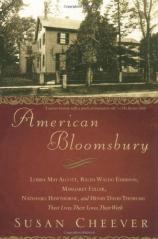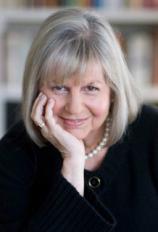American Bloomsbury: Louisa May Alcott, Ralph Waldo Emerson, Margaret Fuller, Nathaniel Hawthorne, and Henry David Thoreau - Their Lives, Their Loves, Their Work
Review
American Bloomsbury: Louisa May Alcott, Ralph Waldo Emerson, Margaret Fuller, Nathaniel Hawthorne, and Henry David Thoreau - Their Lives, Their Loves, Their Work
"What a shock," writes Susan Cheever in AMERICAN BLOOMSBURY about
her arrival in Concord, Massachusetts. "Somehow, I had thought I
would be driving into the nineteenth century." Instead of seeing
Ralph Waldo Emerson talking with Margaret Fuller, Nathaniel
Hawthorne brooding in his study, Bronson and Louisa May Alcott
greeting guests at Orchard House, or Henry David Thoreau crossing
the street near Monument Square, only the ghosts of these writers
remain.
Cheever was in the small, Colonial-era town on a mission: to
recreate the bygone days of one of the most transformative periods
in American history and bring the personal stories of these
literary icons to life in AMERICAN BLOOMSBURY. Her journey to
Concord began when she was asked to write the Introduction to a new
edition of Louisa May Alcott's LITTLE WOMEN, one of her favorite
childhood books. She immersed herself in mid-19th century Concord,
penned the Introduction and "kept on writing."
During the course of her research, she realized that she had found
the topic for her next book: the salacious side of the lives of the
luminaries who once called Concord home. According to Cheever, the
author of several novels and nonfiction books, this was no staid
group of bookish types. Along with writing some of the greatest
works in the pantheon of American literature and forming many of
the ideals that became the basis of modern social thought and
education, Emerson and company were involved in love triangles,
feuds, misunderstandings and tragedies.
An intriguing aspect of AMERICAN BLOOMSBURY is the light Cheever
sheds on the least famous of the subjects covered in the book:
magazine editor and foreign correspondent Margaret Fuller, a
bright, determined woman ahead of her time who captured the fancy
of both Emerson and Hawthorne. (Fuller is the model for Hester
Prynne in THE SCARLET LETTER.) Another lesser known detail is the
support Emerson, Bronson Alcott and others in their circle --- who
abhorred slavery and supported the abolitionist movement --- gave
to John Brown in spite of the fact that Brown cold-bloodedly called
five proslavery men from their homes and executed them.
The Concord set endured their share of misfortune along with fame.
Emerson lost his nine-year-old son, Henry David Thoreau's brother
contracted tetanus after cutting himself while shaving, and
Elizabeth Alcott (the inspiration for Beth in LITTLE WOMEN) died at
the age of 23 from the lingering effects of scarlet fever. And
perhaps most tragically, Margaret Fuller, her Italian husband and
their infant son drowned when the steamer on which they sailed from
Europe went off course and struck a sandbar near the coast of Fire
Island, New York.
We know these writers primarily through the works they left behind
--- LITTLE WOMEN, WALDEN and THE SCARLET LETTER among them. In this
compelling biography, Cheever scratches the surface of history to
reveal an extraordinary place and time populated not by static
figures but by colorful characters who once loved, lost, triumphed,
failed and dreamed.
Reviewed by Shannon McKenna on December 22, 2010
American Bloomsbury: Louisa May Alcott, Ralph Waldo Emerson, Margaret Fuller, Nathaniel Hawthorne, and Henry David Thoreau - Their Lives, Their Loves, Their Work
- Publication Date: September 18, 2007
- Genres: History, Literary Criticism, Nonfiction
- Paperback: 240 pages
- Publisher: Simon & Schuster
- ISBN-10: 0743264622
- ISBN-13: 9780743264624





